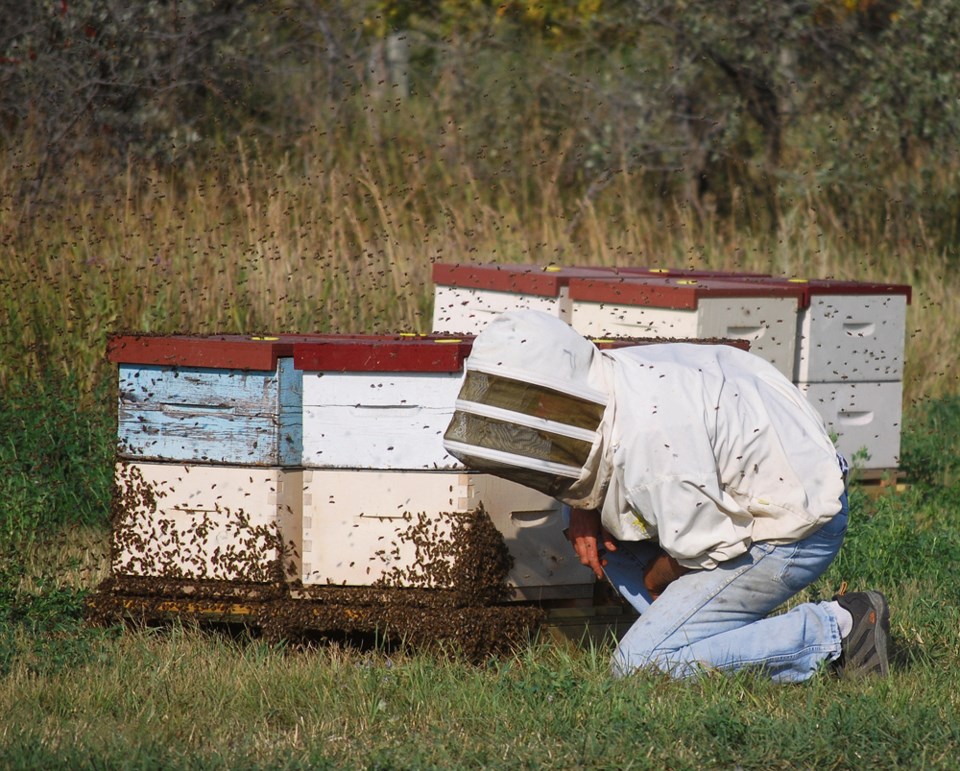Bees, wild and tame, forage for nectar and pollen, so you would think that flowering field crops such as canola and corn would be a pollinator’s haven. But neonicotinoid pesticides used as seed treatments on many crops are now considered a danger to bees and other pollinators.
Announced in late August, Health Canada is proposing to phase out several neonicotinoid pesticides.
Crop producers will have to find alternate methods of controlling flea beetles, the tiny black bugs that can wipe out a canola crop in 36 hours, (August 17 issue of Grain News).
Beekeepers in Manitoba have hives that contact neonicotinoid treated plants.
Virden beekeeper Robert Heath says that while he is having a very good year, he knows some producers have had problems they attribute to neonicotinoid pesticides, particularly in corn pollen.
Persistent pesticide
Bees and other pollinators are not killed outright, but the effects are insidious.
“The bees lose their orientation ability and get lost. So that’s why call it colony collapse,” he explains.
Heath says that neonicotinoids are reckoned to persist in the ground for 35 years.
Although Oak Lake beekeeper Patrick Cox prefers pasture and forage situations for his hives, some colonies are surrounded by crops. He is not sure how that is affecting his honey production.
“It’s hard to know with bees, because they can forage everywhere. I always compare bees to bloodhounds. They can track stuff down within miles of the bee yard. So what they get into – it’s hard to say.”
In general crop spraying is a concern to apiaries.
“Certainly we do have spray damage every once in a while, when farmers have to spray for diamond backed moths, anywhere they are using an insecticide, or for wheat midge.”
Cox understands that producers have pests to fight.
“All I ask is that the farmers spray early in the morning before the bees start flying and try to have the spray drift away from the bee yard.”
When a neonic is used as a seed coating, the pesticide spreads throughout the growing plant and guards it against nibbling insects. “It has been shown that bees are very damaged by insecticides,” says Cox adding that contaminated pollen and nectar is brought back to the beehive, poisoning the hives from within.
Many studies have shown that the chemicals can affect the ability of honey bees to learn and forage, although industry scientists have disputed whether the experiments are realistic enough (www.sciencemag.org/news/2018/02/).
“Ourselves, we haven’t noticed anything major,” says Cox. “You just don’t know how sub-lethal it is. There might be issues we are not aware of. Maybe our hives could be bigger, we just don’t know.”
Producers take notice
Beginning in April of 2018, Health Canada announced their plan to phase out the first of three main neonics, imidacloprid. A new ban proposal for the other two, clothianidin and thiamethoxam is part of the same review says a recent bulletin. The phase-out is planned for the next three to five years.
Non-farm users
Last April, the European Commission voted to ban all outdoor uses of neonicotinoids by the end of 2018. In a December 2017 information bulletin, the Canadian Government stated that neonics “are also used for other purposes, including killing insects in homes, controlling fleas on pets, and protecting trees from invasive insects such as the Emerald Ash borer.”
An American publication, www.greenhousemag.com, states, “Home Depot, the world’s largest home-improvement chain, has announced that it has removed neonicotinoid pesticides from 80 percent of its flowering plants and will complete its phase-out in plants by 2018.”
Mainstream agricultural is searching for a better solution to controlling pests. Home owners, municipal and business grounds keepers also need to find other solutions.




